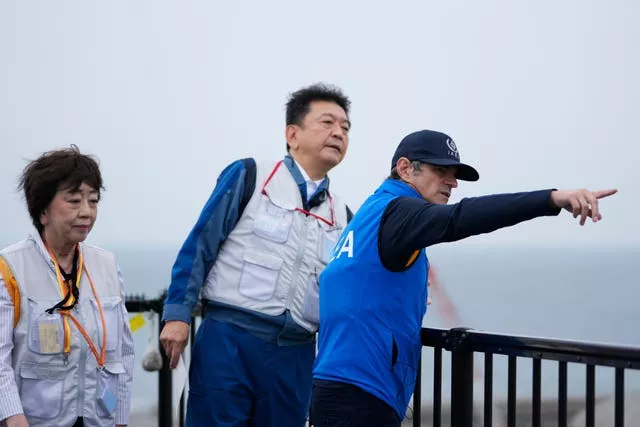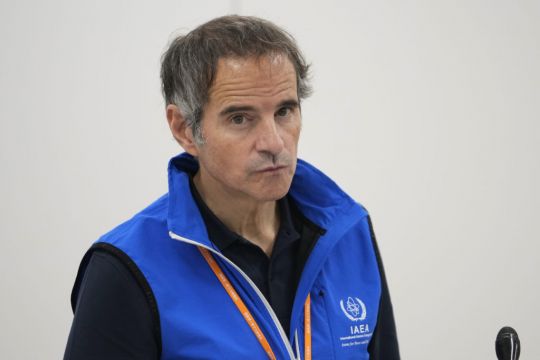The United Nations nuclear chief has toured Japan’s tsunami-wrecked nuclear power plant, including some of the key facilities that will release treated radioactive water into the Pacific Ocean.
The move comes the day after the International Atomic Energy Agency (IAEA) affirmed the safety of the contentious plan.
On the coastal observation “green deck”, IAEA chief Rafael Mariano Grossi observed where the water is treated before being transported through a black pipeline from sampling and mixing tanks to the coastal facility for dilution by at least 100 times using seawater.
It will then be released into the Pacific Ocean 1,000 yards offshore through an undersea tunnel.
Tomoaki Kobayakawa, president of the plant operator, Tokyo Electric Power Company Holdings (Tepco), escorted and briefed Mr Grossi, explaining that the seawater for dilution will be taken from the area further away from the area of the damaged reactors and that the water in the final dilution shaft can also be tested before it gets to the Pacific.
Mr Grossi’s tour of the Fukushima Daiichi plant, which was set to end with a trip by boat to view the water release point, was a highlight of his four-day visit in Japan as a guest of the foreign ministry.
The Japanese government has been trying to gain credibility for the water release, which still faces persistent opposition in and outside Japan.
Earlier on Wednesday, Mr Grossi joined a meeting of government and utility officials, as well as local mayors and fishing association leaders. There, he stressed the continuous presence of the agency throughout the water discharge to ensure safety and to address the residents’ concerns.
“What is happening is not something exceptional, some strange plan that has been devised only to be applied here, and sold to you,” Mr Grossi said in his opening remarks in Iwaki, about 25 miles south of the plant.
“This is, as certified by the IAEA, the general practice that is agreed by and observed in many, many places all over the world.”
“We are going to stay here with you for decades to come until the last drop of the water which is accumulated around the reactor has been safely discharged.”
That means IAEA will be reviewing, inspecting, checking the validity of the plan in the decades to come, he said.
The IAEA, in its final report, concluded the plan to release the wastewater – which would be significantly diluted but still have some radioactivity – meets international standards, and its environmental and health impact would be negligible.

Mr Grossi said the agency is “very confident about it”.
However, local fishing organisations have rejected the plan because they worry that their reputation will be damaged even if their catch is not contaminated.
It is also opposed by groups in South Korea, China and some Pacific Island nations due to safety concerns and political reasons.
Fukushima’s fisheries association adopted a resolution on June 30 to reaffirm their rejection to the treated water discharge plan.
During Wednesday’s meeting, Fukushima fishery association chief Tetsu Nozaki urged government officials “to remember that the treated water plan is pushed forward despite our opposition”.
In an effort to address concerns about the treated water on fish and marine environment, Mr Grossi and Mr Kobayakawa signed an agreement on a joint project to see if or how marine life is affected by tritium, the only radionuclide officials say is completely unremovable.
Much of the Fukushima wastewater contains caesium and other radionuclides, but it will be further filtered until the water is below international standards for all but tritium.
During a briefing on Wednesday, South Korean officials said it is highly unlikely that water with risky contamination levels would be pumped out into the ocean.
Officials also stressed that South Korea plans to maintain tight screening across seafood imported from Japan and that there were no immediate plans to lift the country’s import ban on seafood from the Fukushima region.

A massive earthquake and tsunami on March 11, 2011, destroyed the Fukushima Daiichi plant’s cooling systems, causing three reactors to melt and contaminating their cooling water, which has leaked continuously.
The water is collected, treated and stored in about 1,000 tanks, which will reach their capacity in early 2024.
The government and the plant operator, Tokyo Electric Power Company Holdings, say the water must be removed to prevent any accidental leaks and make room for the plant’s decommissioning.
Japanese regulators finished their final safety inspection last week, and Tepco is expected to obtain the permit for the release in coming days. It could then begin gradually discharging the water any time, as the start date is undecided due to protests at home and abroad.
China doubled down on its objections to the release in a statement late on Tuesday, saying the IAEA report failed to reflect all views and accusing Japan of treating the Pacific Ocean as a sewer.

“We once again urge the Japanese side to stop its ocean discharge plan, and earnestly dispose of the nuclear-contaminated water in a science-based, safe and transparent manner. If Japan insists on going ahead with the plan, it will have to bear all the consequences arising from this,” the Chinese Foreign Ministry said in the statement.
Mr Grossi said treating, diluting and gradually releasing the wastewater is a proven method widely used in other countries – including China, South Korea, the United States and France – to dispose of water containing certain radionuclides from nuclear plants.
Some scientists say the impact of long-term, low-dose exposure to radionuclides remains unknown and have urged a delay in the release.
Others say the discharge plan is safe but call for more transparency in sampling and monitoring.
Prime Minister Fumio Kishida, after meeting with Mr Grossi, said Japan will continue to provide “detailed explanations based on scientific evidence with a high degree of transparency both domestically and internationally”.
Mr Grossi is also expected to visit South Korea, New Zealand and the Cook Islands after his visit to Japan to ease concerns there.







